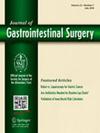Perioperative body composition changes and their clinical implications in patients with gastric cancer undergoing radical gastric cancer surgery: a prospective cohort study
IF 2.2
3区 医学
Q3 GASTROENTEROLOGY & HEPATOLOGY
引用次数: 0
Abstract
Background
This study aimed to investigate perioperative body composition changes and their clinical implications in patients undergoing radical gastric cancer surgery.
Methods
Patient data are prospectively collected. Computed tomography scans were conducted within 30 days preoperatively and on the seventh postoperative day to assess skeletal muscle mass index (SMI), skeletal muscle density (SMD), and subcutaneous adipose tissue (SAT). Changes in these parameters between the 2 scans were quantified. Logistic regression analysis was used to determine factors influencing body composition loss and clinical outcomes.
Results
A total of 335 patients were included, showing varying degrees of decline in SMI, SMD, and SAT during the perioperative period. Multivariate analysis identified age ≥65 and low handgrip strength as independent risk factors for excessive SMI loss, whereas laparoscopic surgery served as a protective factor. For excessive SMD loss, independent risk factors included preoperative low SMD, Nutritional Risk Screening 2002 score ≥3, and hypoalbuminemia. Moreover, age ≥65 was identified as an independent risk factor for excessive SAT loss, whereas laparoscopic surgery remained protective. Excessive SMI and SMD loss are correlated with increased postoperative complications, prolonged hospital stays, and higher costs. Both excessive losses in SMI and SMD are independently associated with the incidence of postoperative complications. Further analysis revealed that excessive SMD loss (odds ratio, 3.164; 95% CI, 1.214–8.243) independently contributed to readmission risk.
Conclusion
Excessive SMI and SMD loss are associated with adverse clinical outcomes. It is essential to address and improve preoperative modifiable risk factors to reduce perioperative muscle loss and enhance prognosis.
接受胃癌根治术的胃癌患者围手术期身体成分变化及其临床意义:一项前瞻性队列研究。
背景:本研究旨在探讨胃癌根治术患者围手术期身体成分变化及其临床意义:本研究旨在调查胃癌根治术患者围手术期身体成分变化及其临床意义:方法:前瞻性收集患者数据。术前 30 天内和术后第七天进行计算机断层扫描,评估骨骼肌质量指数(SMI)、骨骼肌密度(SMD)和皮下脂肪组织(SAT)。对两次扫描之间这些参数的变化进行了量化。采用逻辑回归分析确定影响身体成分损失和临床结果的因素:共纳入 335 名患者,他们在围手术期的 SMI、SMD 和 SAT 均有不同程度的下降。多变量分析发现,年龄≥65岁和低握力是SMI过度下降的独立风险因素,而腹腔镜手术则是一个保护因素。SMD损失过多的独立风险因素包括术前低SMD、2002年营养风险筛查评分≥3分和低白蛋白血症。此外,年龄≥65岁也是SAT丢失过多的独立风险因素,而腹腔镜手术仍具有保护作用。SMI和SMD损失过多与术后并发症增加、住院时间延长和费用增加有关。SMI和SMD的过度损失都与术后并发症的发生率独立相关。进一步分析表明,SMD损失过多(几率比3.164;95% CI,1.214-8.243)会导致再入院风险:结论:过度的SMI和SMD损失与不良临床结果有关。结论:过度的 SMI 和 SMD 损失与不良的临床结果有关,因此必须解决并改善术前可改变的风险因素,以减少围手术期的肌肉损失并改善预后。
本文章由计算机程序翻译,如有差异,请以英文原文为准。
求助全文
约1分钟内获得全文
求助全文
来源期刊
CiteScore
5.50
自引率
3.10%
发文量
319
审稿时长
2 months
期刊介绍:
The Journal of Gastrointestinal Surgery is a scholarly, peer-reviewed journal that updates the surgeon on the latest developments in gastrointestinal surgery. The journal includes original articles on surgery of the digestive tract; gastrointestinal images; "How I Do It" articles, subject reviews, book reports, editorial columns, the SSAT Presidential Address, articles by a guest orator, symposia, letters, results of conferences and more. This is the official publication of the Society for Surgery of the Alimentary Tract. The journal functions as an outstanding forum for continuing education in surgery and diseases of the gastrointestinal tract.

 求助内容:
求助内容: 应助结果提醒方式:
应助结果提醒方式:


